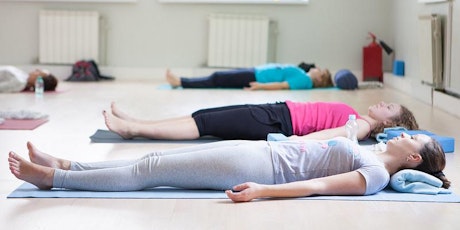When I am tired, stressed, and ready to end the day I turn to certain yoga styles and avoid the more fast paced and strenuous styles. These are three of my favorite night yoga styles that recommend to try at least once.
In general, these styles offer slower, cooling, and more passive poses. It does depend on the teacher, but try to explore different classes and don’t give up if you don’t like the first one that you try!
1. Yin Yoga

There was a teacher who would teach Yin Yoga where I used to study. They were usually the latest class on the schedule. I looked forward to these classes because it was super relaxing and I had a stressful job at the time.
The unique thing about Yin Yoga is that it is a completely Passive practice. Yin yoga goes through a series of stretch poses and lets you stay in one pose from 1-5 minutes at a time. So Child’s Pose could take up to 10 minutes!
It works by allowing the stretch to enter into your deep tissues. It also develops a release quality as you are instructed to completely let go, instead of engaging muscles you release them.
Gather pillows, and props to help you release no matter what level you are at. The great thing is that this type of yoga allows you widen and advance your hip poses including the “splits”.
2. Moon Salutation – Chandra Namaskar

The Moon Salutation is different from the Sun Salution (Surya Namaskar). It will help you to cool down, rejuvenate and relax. This sequence is designed for the night time, and for honoring the moon cycles. The Moon Salutation goes in a different direction than the Sun Salutation. It starts on the right side of the mat, we move sideways, and then end on the left side. The sequence is repeated the opposite way, ending on the right side.
There are different versions, which I encourage you to try both traditional and modern. The famous yoga teacher Shiva Rea teaches her version with before and after meditations and a lunar theme chanting option for each pose. This sequence acknowledges the need for a balanced harmony between our hot and cold energies. When you balance these energies prepare yourself for a spiritual union.
The Moon Salutation poses include: Standing Sidebend, Goddess Pose, Triangle Pose (Trikonasana), Malasana. Anahatasana, Anjali Mudra, etc.
The traditional lunar chant is “Om somaya namaha”.
3. Slow Hatha Class

Hatha Yoga focuses on balancing energies and connecting consciousness with your vital forces. In a slow Hatha class, low intensity poses work to cool the body and the mind down.
These can range in level and intensity, but the slower ones are great for late nights when you want to tune into your breath, body, and become more mindful. The teacher will guide you through holding a pose while breathing and often offer pure breathing exercises. Guided meditations might be used or a simple meditation at the end.
Common poses include floor poses, cat and cow, and inversion poses. Have a blanket ready in case you get cold during Savasana Pose (typically the last pose of the class).
To sum up, look out for these classes Yin Yoga (Passive), Moon Salutation (Moon Inspired sequence) and Slow Hatha (slow paced Yoga with breathing and meditation). Give your self permission to indulge in some relaxation and reconnection of your mind, body and Spirit. Also make sure to wear comfortable yoga leggings because you will feel better; you can shop some of them here.

